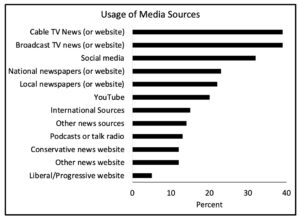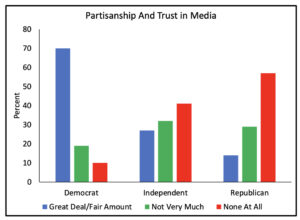The media sources from which an American receives information is considered one of the most important factors for predicting that person’s political views. Research has not firmly established whether the media influences views or whether people simply selectively pick media sources that align with their existing ideas. So, what are the differences in the media diet of Republicans and Democrats? Does one party trust the media more than the other? What do we make of the changing media landscape that includes a growing number of digital media sites?
How many news sources does the average American regularly consult for information about government and public policy?
The average American watches over four hours of television daily. In 2020, over 15% of the American electorate watched an average of 8 hours or more of MSNBC, CNN, or Fox News per month. Over 1 in 4 Americans consume at least 1 hour of partisan media a month, which is roughly equivalent to 30 separate 30-second TV commercials per week. The average partisan visits about 3 different online news sources a week.
What media sources are widely-used? Which ones are less-used?
Major broadcast and cable news are still the most widely used sources of political information. A YouGov poll in 2022 found that 39% of U.S. adults used either cable or broadcast news, including their websites, for political news. The next highest were social media at 32% and national newspapers, including their websites, at 23%. News consumption across platforms indicate print and radio are the least used platforms.
Over the past few decades, news media has shifted from primarily print and broadcast productions to primarily digital platforms. Digital media consists of both news websites and apps as well as social media platforms. 86% of adults say they get news on digital devices, more so than TV, radio, or print. While social media is a significant source of digital news, two-thirds of adults say they also access news websites, news apps, and search engines.
The rise of digital media has generated different modes of behavior across age cohorts. Over 71% of young adults aged 18-29 consume news information primarily through digital devices compared to only 48% of those aged 65 and above. Moreover, the younger cohort behaves differently when online.
While most age groups utilize news websites to obtain information, younger Americans (ages 18-29) are more likely to use social media for political news information rather than other digital sources like news websites, search engines, and podcasts. 42% of young adults use social media as their main source of information whereas only 28% of young adults utilize actual online news websites. Among the users of online news sites, Americans visited Fox News and CNN the most with 16% and 12% respectively of US adults citing those two media moguls as their primary source of information.
How much does the public trust the media?
Americans expressed doubts about the media or “the press” even before the days of social media. Trust in media institutions as a whole has dramatically decreased over the past 50 years. In fact, for the first time since 1972, the percentage of respondents who have a great deal or fair amount of trust in mass media is lower than the percentage with no trust at all in mass media. Trust in mass media is 34% among Americans, while those with no trust at all climbed to 38% in 2022.
Trust in the media differs by partisanship. Republican trust in the media plummeted to new lows during the 2016 election, while Democrat trust simultaneously reached new heights. Trust has remained about the same for the two parties since, but independents have experienced declines since 2018.
Additionally, U.S. adults under the age of 30 now trust information they gather from social media sites almost as much as from national news outlets. The trust in social media sites is significantly lower among every other age group. Local news is the most trusted news source among all age groups.
Do most Americans seek out a wide range of news sources, or only those they are likely to agree with?
Americans are increasingly consuming partisan news. Fox News and CNN are the most cited sources of political media by Americans. Additionally, few Americans consume news that crosses with the other political opinion, meaning they are more comfortable with their own partisan echo chambers. For example, someone who watches MSNBC will not likely watch Fox News and vice versa. However, both Republicans and Democrats split their news consumption between the extreme of their political spectrum and moderate, mainstream sources. This means partisans also engage in non-partisan news.
The strength of an individual’s partisanship influences their motivation to engage the media. Strong partisans are more motivated to seek out political information, despite its possible skew, than weaker partisans. The former also prioritize consuming political media over entertainment-based media. One implication of this trend is that the media is not as responsible for producing partisans as some assume; strong partisans seek out aligned media, not the other way around. Additionally, strong partisans are more likely to consume news when their preferred side seems to benefit from an event.
What are the differences in the news consumption habits of Republicans and Democrats?
Both sides consume biased news information. However, studies have found that democrats lean on social media more than republicans with 55% of the former consuming information from social media compared to 40% of the latter. More specifically, democrats access social media for political news at a higher rate than Republicans; although, the younger age of the average democratic voter may explain some of this variation as younger people are more likely to use social media for news regardless of party.
Over 93% of individuals whose main news source is Fox News identify as a Republican. Similarly, nearly 95% of those who rely on MSNBC identify as a Democrat. The partisans on both sides selectively consume news that aligns with their views, cutting out any news from the other party. One significant difference is that Democrats seek news from a wider array of mainstream news sources, such as MSNBC, CNN, the New York Times, and NPR. In contrast, Republicans largely rely on a single mainstream news source, Fox News. This difference, however, may be tied to the programming of many mainstream news sources as they tend to share political views which slant left-leaning towards Democrats. The low levels of trust in traditional media sources, primarily with conservatives, may have likely contributed to the increasing number of alternative, hyperpartisan news outlets such as Brietbart and the Daily Wire. In fact, the United States has the largest number of right-wing online-only news sources.
Nielsen ratings have indicated that following the departure of Tucker Carlson from Fox News, far-right conservative cable news networks such as One America News and Newsmax have experienced significant increases in viewership. Fox News is still the overall leader in viewership, but it has dropped among the 25-54 age demographic. Immediately following Carlson’s departure, Fox fell below both CNN and MSNBC for that demographic for their 8 o’clock primetime hour that Carlson used to hold. Meanwhile Newsmax had an audience growth for the 8 o’clock hour of about 25% from the same time the previous week. While Fox News is still the overwhelming favorite cable news source among Republicans, there has been significant growth in alternative far-right news outlets. There may be consequences for the availability of reliable information for both Republicans and Democrats, especially considering that an uptick in “fake news” was consumed by both parties during the 2016 election.
Over the last generation, the number and variety of media sources has greatly expanded. How have Americans responded to this change?
One benefit of social media is that it provides short and quick anecdotes about complex issues. However, although social media has made information more accessible, it has also oversaturated the market with misinformation. Moreover, social media posts are often not able to portray the complexity of current political issues due to character/word length and image count restrictions, meaning that critical details may be lost or purposely not included.
Podcasts are another growing area for media consumption. Much like social media, podcasts have risen in popularity over the last decade. Almost half of Americans have listened to a podcast in the last year and 20% say they listen to a podcast every day. Most podcast listeners report learning about some news from podcasts, but only 20% listen to a podcast connected to a news organization. Despite so few Americans listening to news-anchored podcasts, 87% say they expect the news they hear on podcasts to be accurate. As a reflection of their growing popularity, investments in podcasts have increased over the last few years. For example, Spotify invested $200 million dollars in the Joe Rogan Experience podcast, which is consistently the most listened to podcast worldwide.
There have been calls for government regulation to limit misinformation and hold new media sources, like podcasts and social media, to the same standards of liability as traditional media sources. Congress has held multiple hearings with tech industry leaders to gather information about potential regulation. The spread of partial and misinformation related to elections, COVID and other major events has led to a new heightened attention to social media regulation. Potential policy changes include regulation by the government and improved content moderation by platforms. Policy surrounding new media has yet to play out but walks a fine line of freedom of speech and liability issues.
How does media usage vary between well-informed and less-informed citizens?
The ability of partisan media to influence the political opinions of news consumers depends on who is actually consuming the media with strong partisans more open to messages in the media that resonate with their political beliefs. Similarly, consumers of social media may be more susceptible to false information or receiving a limited perspective on the situation at hand. Americans who get most of their information from social media tend to have less education as well as a lower household income. Moreover, people who primarily use social media are less politically knowledgeable and more likely to have heard conspiracy theories. During the 2020 Presidential election, those who relied on social media as their primary source of information were the least likely to be following news coverage of candidates.
Further Reading
Grieco, E. (2020). Americans’ main sources for political news vary by party and age. Pew Research Center. https://tinyurl.com/yts6f44s
Broockman, D., & Kalla, J. (2023, April 14). Selective Exposure and Partisan Echo Chambers In Television News Consumption: Evidence from Linked Viewership, Administrative, and Survey Data. https://doi.org/10.31219/osf.io/b54sx
Prior, M. (2013). Media and Political Polarization. Annual Review of Political Science, 16. https://doi.org/10.1146/annurev-polisci-100711-135242
Sources
How many news sources does the average American regularly consult for information about government and public policy?
Broockman, D., & Kalla, J. (2023). Selective Exposure and Partisan Echo Chambers In Television News Consumption: Evidence from Linked Viewership, Administrative, and Survey Data. https://doi.org/10.31219/osf.io/b54sx
Tyler, M., Grimmer, J., & Iyengar, S. (2021). Partisan Enclaves and Information Bazaars: Mapping Selective Exposure to Online News. The Journal of Politics 84(2), 1057-1073. https://doi.org/10.1086/716950
What media sources are widely-used? Which ones are less-used?
Sanders, L. (2022). Trust in Media 2022: Where Americans Get Their News and Who They Trust for Information. YouGov. https://tinyurl.com/y2xduz95
Forman-Katz, N., & Eva Matsa, K. (2022). News Platforms Fact Sheet. Pew Research Center. https://tinyurl.com/3h3dt59z
Shearer, E. (2021). More than eight-in-ten Americans get news from Digital Devices. Pew Research Center. https://tinyurl.com/2s3vune6
Grieco, E. (2020). Americans’ main sources for political news vary by party and age. Pew Research Center. https://tinyurl.com/yts6f44s
How much does the public trust the media?
Schudson, M. (2022). What Does “Trust in the Media” Mean? Daedalus, 151(4), 144–160. https://www.jstor.org/stable/48696778
Brenan, M. (2022). Americans’ Trust in Media Remains Near Record Low. Gallup. https://tinyurl.com/mv57ur46
Liedke, J. (2022). U.S. adults under 30 now trust information from social media almost as much as from national news outlets. Pew Research Center. https://tinyurl.com/2p8vpywh
Brenan, M. (2022). Americans’ Trust in media remains near record low. Gallup.com. https://tinyurl.com/3x3eskvs
Do most Americans seek out a wide range of news sources, or only those they are likely to agree with?
Grieco, E. (2020). Americans’ main sources for political news vary by party and age. Pew Research Center. https://tinyurl.com/yts6f44s
Broockman, D., & Kalla, J. (2023, April 14). Selective Exposure and Partisan Echo Chambers In Television News Consumption: Evidence from Linked Viewership, Administrative, and Survey Data. https://doi.org/10.31219/osf.io/b54sx
Tyler, M., Grimmer, J., & Iyengar, S. (2021). Partisan Enclaves and Information Bazaars: Mapping Selective Exposure to Online News. The Journal of Politics, 84(2), 1057-1073. doi: https://doi.org/10.1086/716950
Graber, Doris A. (2008). Political Psychology 29(4), 615–617. http://www.jstor.org/stable/20447148
Prior, M. (2013). Media and Political Polarization. Annual Review of Political Science, 16. https://doi.org/10.1146/annurev-polisci-100711-135242
What are the differences in the news consumption habits of Republicans and Democrats?
Mitchell, A., Jorkowitz, M., Baxter Oliphant, J. & Shearer, E. (2020, July 30). Demographics of Americans who get most of their political news from social media. Pew Research Center. https://tinyurl.com/ycktxxvx
Graber, D. A. (2008). [Review of Post-Broadcast Democracy: How Media Choice Increases Inequality in Political Involvement and Polarizes Elections, by M. Prior]. Political Psychology, 29(4), 615–617. http://www.jstor.org/stable/20447148
Over the last generation, the number and variety of media sources has greatly expanded. How have Americans responded to this change?
Shearer, E. (2021, January 12). More than eight-in-ten Americans get news from Digital Devices. Pew Research Center. https://tinyurl.com/2s3vune6
Shearer, E., Liedke, J., Eva Matsa, K., Lipka, M., & Jurkowitz, M. (2023, April 18). Podcasts as a source of News and Information. Pew Research Center. https://tinyurl.com/mrcrmjpp
Wirtschafter, V. (2023, February). Audible Reckoning: How Top Political Podcasters Spread Unsubstantiated and False Claims. Brookings Institute.https://tinyurl.com/3jm4ahtd
Saurwein, F., & Spencer-Smith, C. (2020). Combating Disinformation on Social Media: Multilevel Governance and Distributed Accountability in Europe, Digital Journalism, 8(6), 820-841. https://doi.org/10.1080/21670811.2020.1765401
Heft, A., Mayerhöffer, E., Reinhardt, S., & Knüpfer, C. (2020), Beyond Breitbart: Comparing Right-Wing Digital News Infrastructures in Six Western Democracies. Policy & Internet, 12, 20-45. https://doi.org/10.1002/poi3.219
How does media usage vary between well-informed and less-informed citizens?
Broockman, D., & Kalla, J. (2023). Selective Exposure and Partisan Echo Chambers In Television News Consumption: Evidence from Linked Viewership, Administrative, and Survey Data. https://doi.org/10.31219/osf.io/b54sx
Mitchell, A. (2020, July 30). Americans who mainly get their news on social media are less engaged, less knowledgeable. Pew Research Center’s Journalism Project. https://tinyurl.com/ycktxxvx
This policy brief was prepared in June 2023, with research by Mary Stafford and Zul Norin, drafting by Griffin Reid, editing by Dr. Nicholas Clark and Dr. William Bianco, with subject matter expertise from Dr. Josh McCrain




